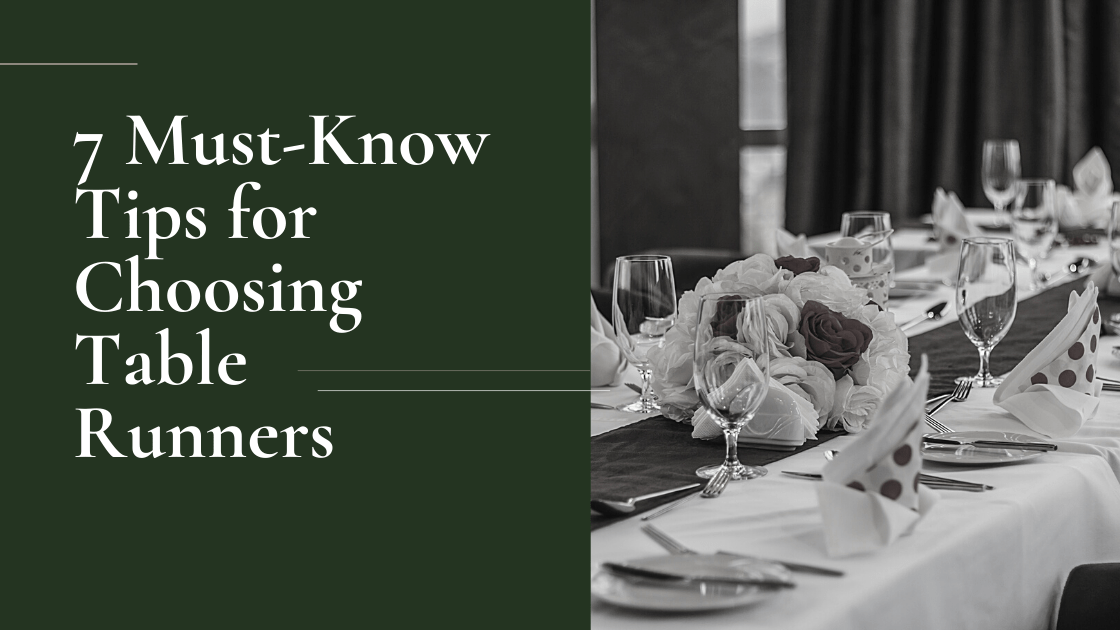7 Must-Know Tips for Choosing a Table Runner

A table runner is one of the most versatile pieces of table linens that you can own. Useful in so many parts of your décor, table runners are available in any material, style, color, and length imaginable. All of these choices can be overwhelming, but keep reading for some tips to help you choose the best one for your needs.
- How to choose the right size table runner. Of all questions asked about table runners, this is the most popular. This seems to be pretty straight-forward, but there are some questions to answer before knowing exactly what to measure, and what to do with those measurements
-
- What are your table’s dimensions? No matter if it is being used on a dining table or on another table in the home, measuring the dimensions of the table is the crucial first step. Don’t forget to include any lip that might be around a table’s edge in your measurement.
- Will the table runner be used down the table’s center, or placed horizontally instead of placemats? If used down the center, there is a formula to choose the correct runner width: measure the table’s width and divide by three. If the table runner or runners will be positioned to serve as placemats, they should be 16 to 20 inches wide.
- Are you using the table runner with a tablecloth? Usually, a table runner length hangs at least six inches over each end of the table, no matter if it’s being used with or without a tablecloth. You can opt for a longer overhang, but if using it with a tablecloth, it should always be shorter than the end of the cloth.
- Consider the surface being covered with your table runner when choosing the fabric, because its performance and style can influence the best choice for your table. For formal tables and those with glossy surfaces, like glass or lacquered wood, consider choosing table runners made from polyester, satin, or silk. For a table made of wood or metal in less formal style, consider choosing a cotton, twill, or burlap table runner.
- Use a short table runner as the base of an informal centerpiece. For this use, the length should leave room on each end of the table for a place setting. Choose a complementary fabric and center your floral arrangement or decorations on top of it. For example, a rustic farmhouse-style table runner would look great under a pewter pitcher filled with daisies. A holiday centerpiece could be foliage from a holly bush and festive candles on top of a thematic table runner. For practical purposes, a table runner can protect your tabletop or tablecloth from scratches, candle-wax drippings, and water rings.
- Your table runner color choice will influence how your overall table decorations and settings look. Using a solid color table runner under a colorful centerpiece can really make an accent color pop. Conversely, using a colorful table runner can be a great base for an otherwise monochromatic centerpiece. Don’t abandon the idea of featuring the table runner itself as the centerpiece, using it as an oversized trivet for a dinner served family-style. For this use, be sure to choose a thick fabric table runner to protect the table underneath.
Using a solid purple or green table runner under this arrangement would make those flowers really stand out.
- Table runners aren’t just for the dinner table. You can use a table runner on any table, like a coffee table or entry table, to protect its surface or add some color and softness to any room. A table runner can serve as protection from drinks or scratches. If you plan to use a table runner in place of coasters to protect the surface of a table, like a coffee table, consider buying a runner that covers much of the surface, leaving only a small band of table visible around the edges. Otherwise, the rules for fitting a table runner to other tables follow the same guidelines as a dinner table.
- Match your table runner purchase to the occasion. There are many table runner choices for holidays, like Thanksgiving, Christmas, and Hanukkah. You can buy either a holiday-themed table runner or a color that matches your other holiday décor, like a blue table runner for Hanukkah or a gold table runner for Thanksgiving.
Another occasion for which you might want table runners is a wedding reception or other large dining occasion. For those, you should consider buying table runners in bulk and choose a material that is low maintenance. The large selection of table runners from iQLinens.com will match any color scheme and is available for bulk purchase.
- Use two table runners on a table for four. When a square or round table is set to seat four diners, using a pair of table runners can be an unexpected look for your table settings. The table runners should cross in the middle of the table and drape over the ends, providing an area for a place setting for each seat. Having a wider table runner to accommodate a full place setting is ideal. Also, the material should not have an uneven surface because it’s important that a glass or plate sits securely in place. We recommend avoiding beaded or quilted table runners for this use.
Hopefully, these tips for choosing a table runner for your dining room table or other use are helpful. There are many beautiful options from which to choose, and you can easily end up with more than you need for a special occasion!
To find a huge inventory of table runners, you need look no further than iQLinens.com. You’ll find multiple shades of any color you can imagine from classic red, black, or white to bubblegum pink and royal purple. Plus, you’ll find many choices of material from formal satin polyester to fancy taffeta to farmhouse burlap. Buy individually or in bulk for any of your upcoming occasions.
